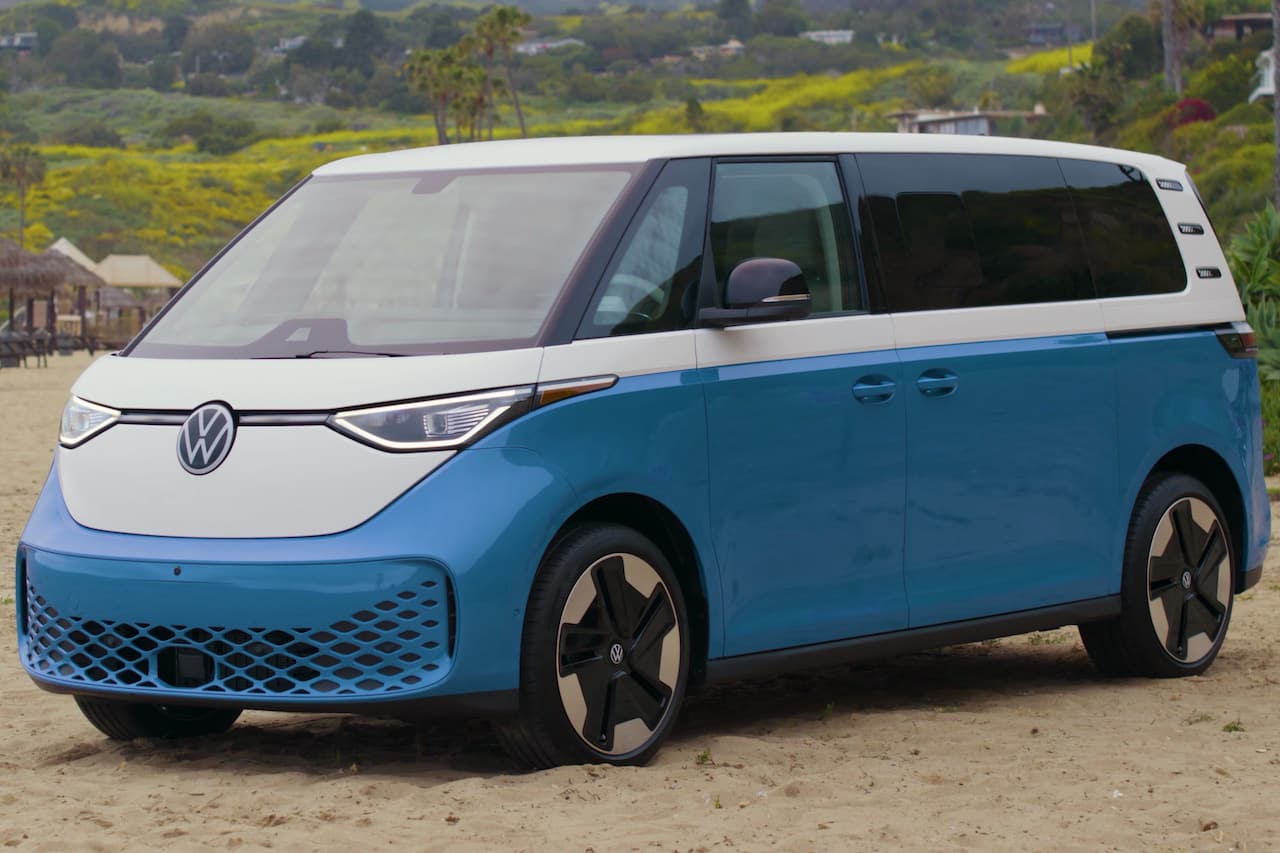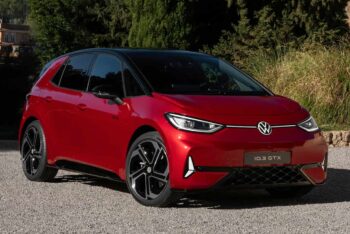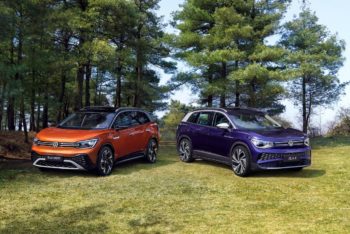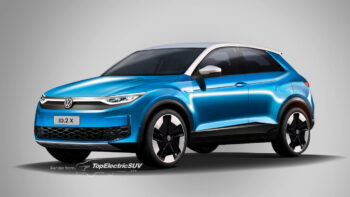Update: ‘Significant customer interest recorded at U.S. dealers’ section updated.
After spurring rumors about the comeback of the VW bus in the U.S. for years, Volkswagen confirmed at the 2017 Pebble Beach Concours d’Elegance that it indeed has a plan. Well, the moment is finally here, as the 21st century VW bus, introduced as the VW ID. Buzz in 2022, has finally reached American shores. And we mean that literally, with the debut held at surfer hotspot Huntington Beach.
The American favorite of surfers and adventurers is now clean, futuristic, 100% electric, and loaded to the brim with comfort and convenience features. Here’s a comprehensive look at Volkswagen’s electric minivan, which will have its sales launch next year:
Design
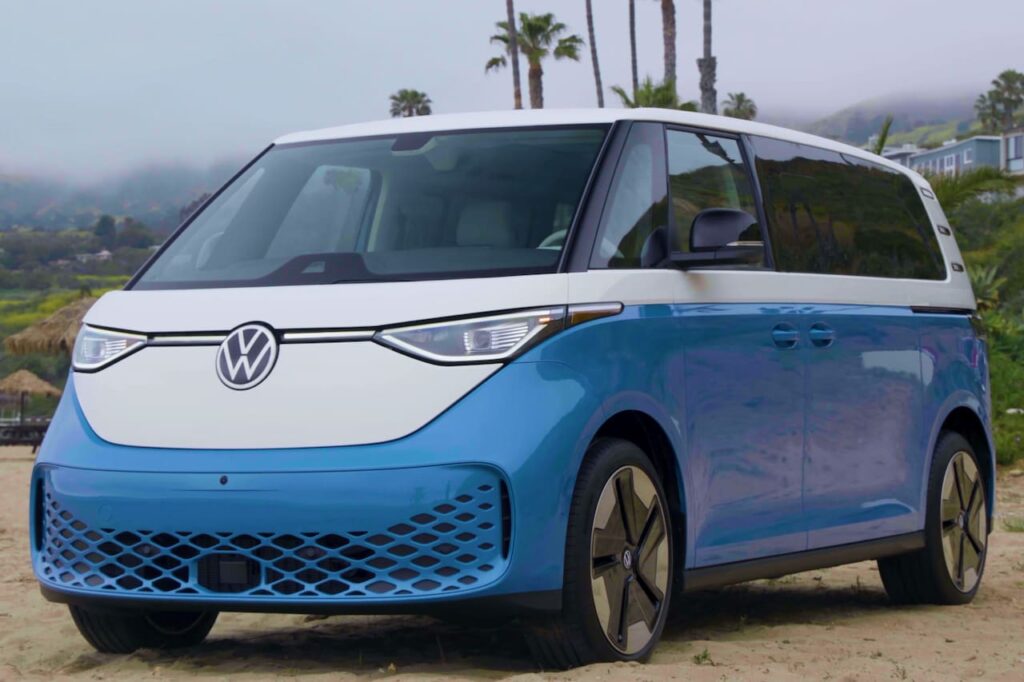
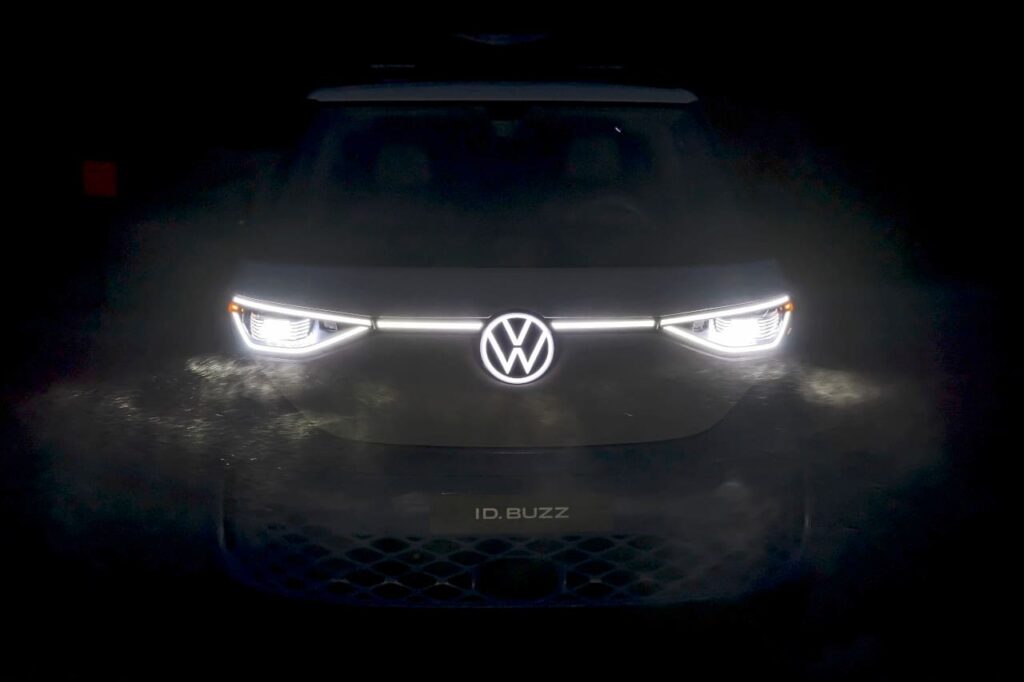
The VW ID. Buzz is a daring futuristic interpretation of the VW Bulli, which first appeared as the VW T1 in 1950. Volkswagen designers haven’t gone overboard with retro looks, though. The overall design comes from the VW ID. Buzz concept unveiled at the 2017 Detroit Auto Show, with a friendly and emotional character.
Globally, the VW ID. Buzz is available in a normal wheelbase (NWB) version, the one which debuted in Europe in 2022, and the long-wheelbase (LWB) version which debuted in the U.S. and the one you’re looking at here. Both versions have an almost identical design. Only the latter is making it to the U.S., so that’s the one we’re detailing here.
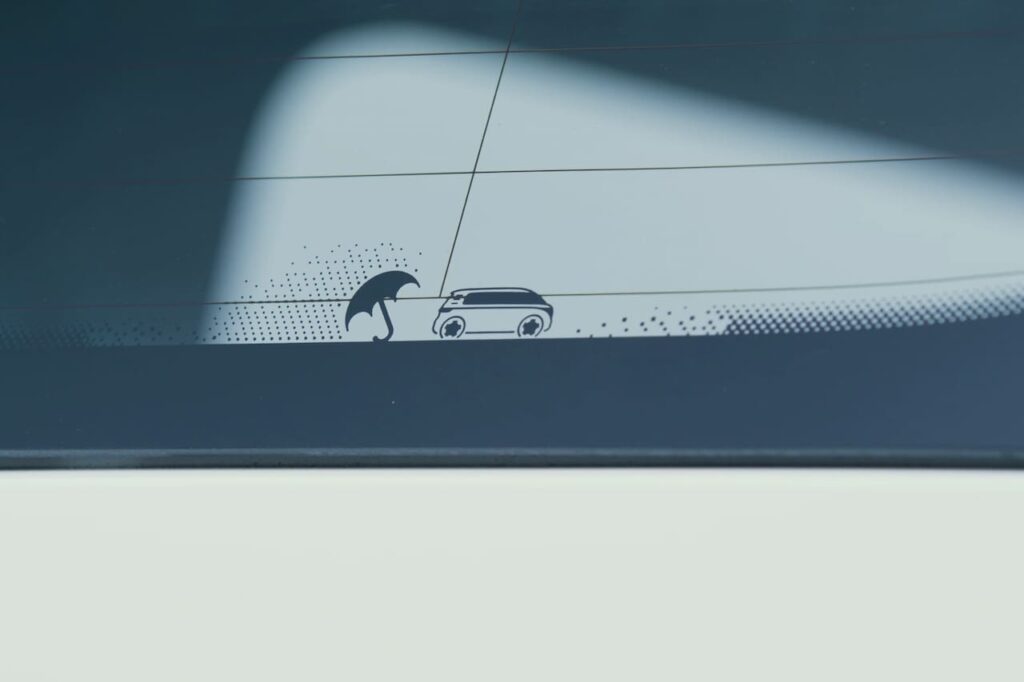
The VW ID. Buzz mixes curvy and sharp elements. It has a signature V-shaped hood, a honeycomb design in the front bumper, charismatic headlights incorporating the IQ.Light LED matrix technology, squarish windows, and slim horizontal LED tail lights. Then there are some true tell-tale EV signs, like short overhangs, aero wheels, an LED strip between the headlights, an end-to-end light strip at the rear, etc.
Unlike the Euro-spec ID. Buzz (both NWB and LWB), the U.S.-spec ID. Buzz features an illuminated brand logo at the front. Another visual difference is that the latter has an orange marker light and an orange reflector integrated into the headlights.
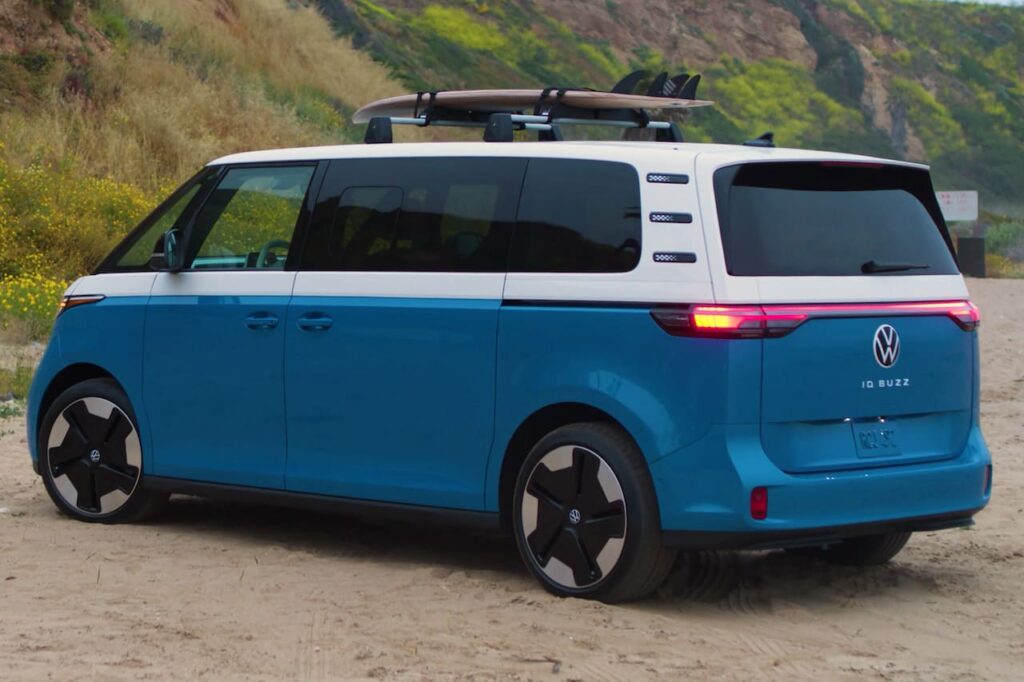
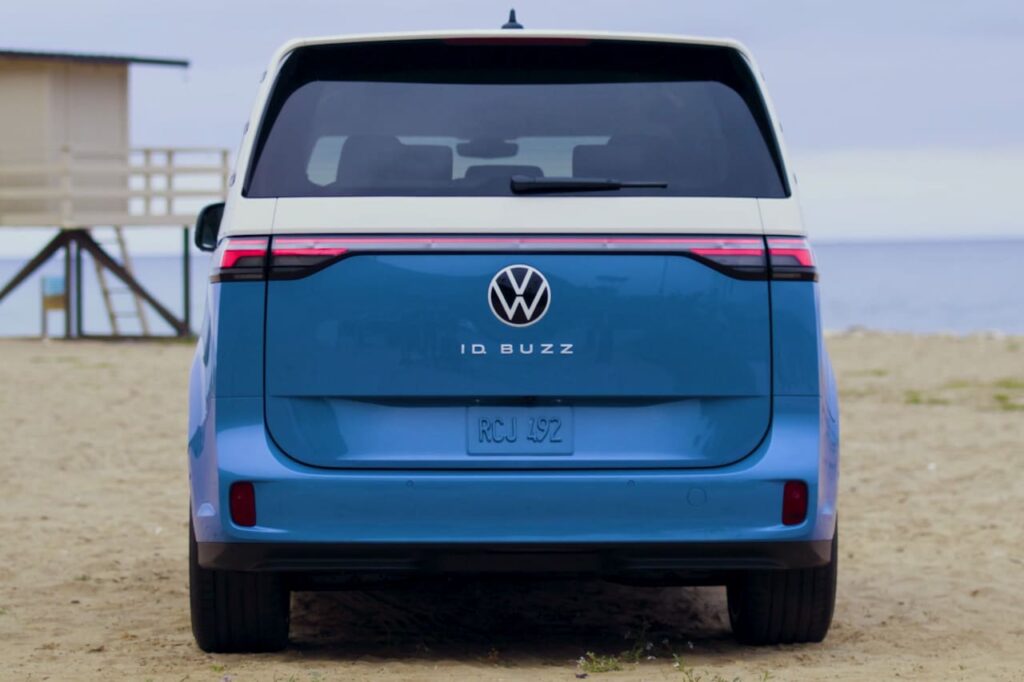
The ID. Buzz has quite a character on the sides. Besides the headlights extending into the fenders, it has a proper MPV-style four-part window area. The chunky wheels, short overhangs, and boxy body make the MPV stubby yet very charming. The classic sliding windows, which are fully powered, are the only tell-tale sign of the LWB version. Needless to say, the power-sliding doors are visibly longer.
Volkswagen says it will offer the ID. Buzz in the U.S. with 20-inch wheels. However, as you can see in the images here, the company has showcased it with the 21-inch Bromberg wheels. These wheels, which are a full five inches larger in diameter than a 1950 T2 model’s, are wrapped in 235/45 R21 (front)/265/40 R21 (rear) Hankook Ventus S1 evo 3 ev tires.
Colors
The ID. Buzz will be available in no less than six colors in the U.S.:
- Cabana Blue
- Metro Silver
- Indium Grey
- Energetic Orange
- Pomelo Yellow
- Mahi Green
Interior
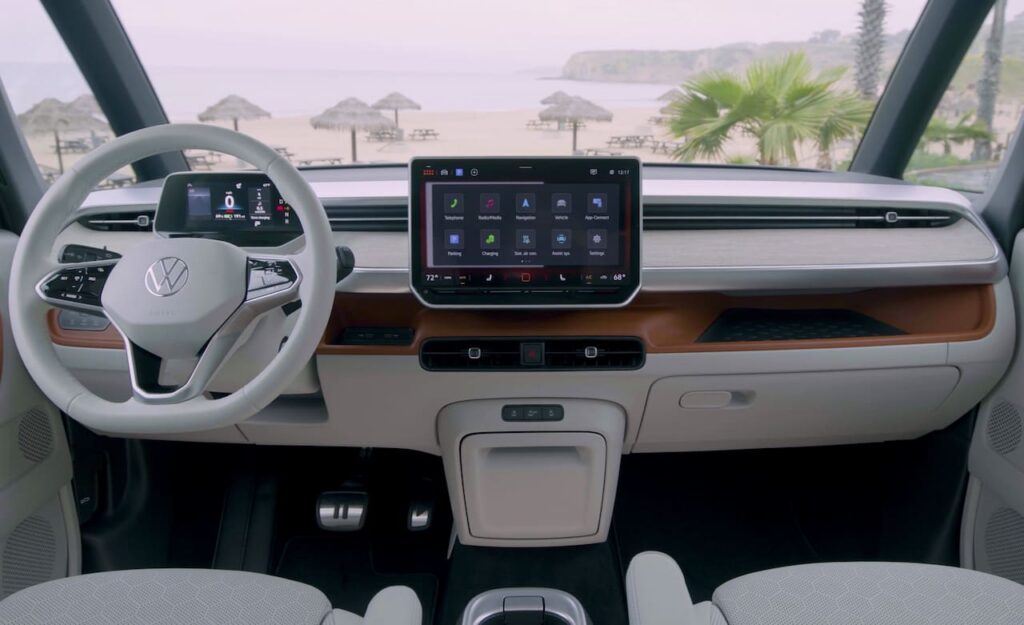
The interior of the VW ID. Buzz LWB looks quite similar to the VW ID.4, but there are some upgrades here, brought from the ID.7. The cabin is airy and light with an Open Space theme, with a lounge-like atmosphere. It looks clean and straightforward but relatively modern and upmarket for a people mover.
Cockpit
The compact steering wheel has a flattish center cap and touch-sensitive controls. On the left of the driver is a control panel housing the light and vision functions, followed by a round AC vent. A floating touchscreen panel for the infotainment system, upgraded in line with the ID.7, resides in the middle of the dashboard.
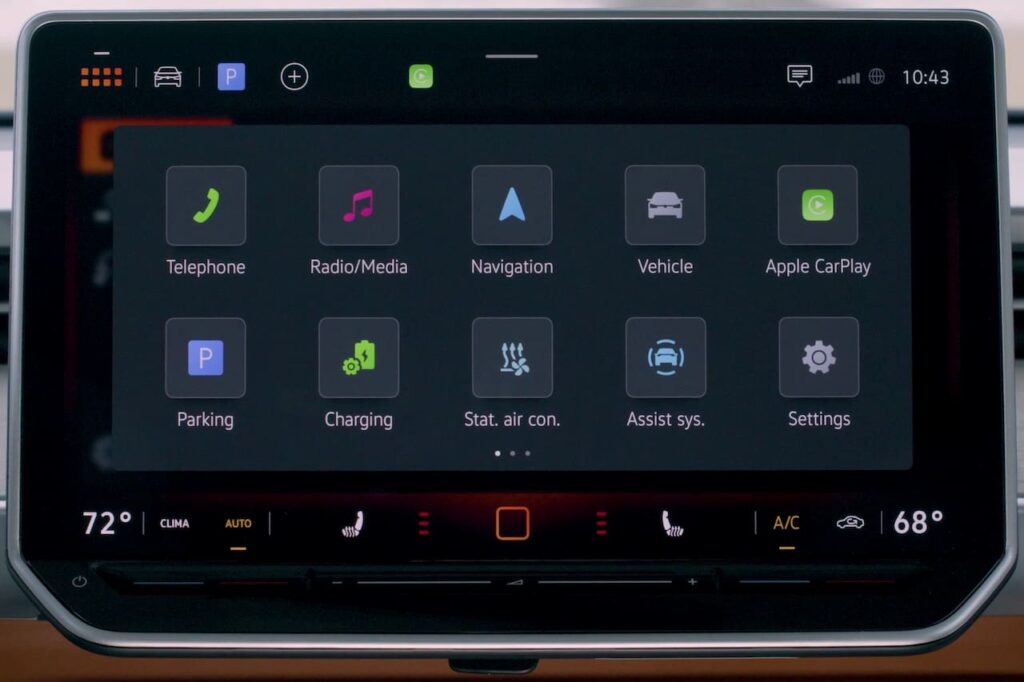
While the ID. Buzz that’s available in Europe since 2022 comes with a 10- or 12-inch infotainment, the electric minivan that will be launched in the U.S. has a 12.9-inch infotainment display. The touchscreen infotainment system is simpler, more intuitive, and more customizable. It allows the user to access the main menu with a new direct access function on the left of the top bar.
An inclined surface below the central display has sliders to adjust the audio volume and temperature. Unlike the ID. Buzz NWB that’s already on sale in other markets, the U.S.-bound ID. Buzz LWB has illuminated touch sliders. One more enhancement here is that the climate functions have been integrated into the bottom of the touchscreen.
Finally, right behind the steering wheel sits a compact, 5.3-inch digital instrument cluster along with a rocker switch to select the drive modes and activate the parking brake. A head-up display is also an additional feature for the U.S. market.
Seats
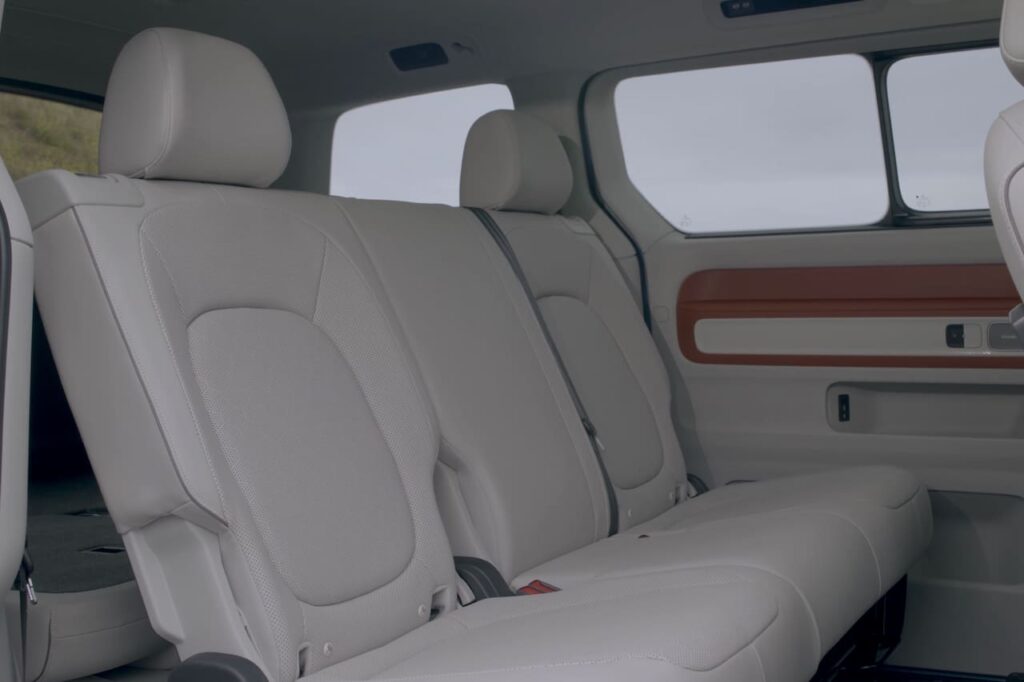
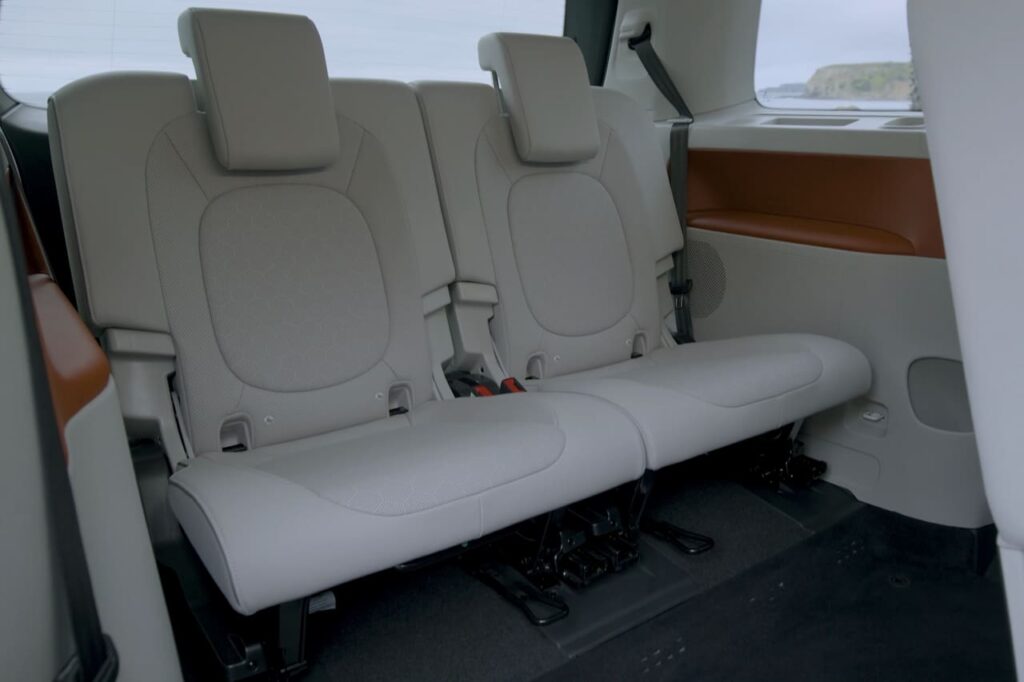
The ID. Buzz LWB has a nearly 10-inch longer wheelbase than the ID. Buzz NWB, and it utilizes that extra space for the third row of seats. Seven seats with a bench in the second row is standard, while an upgrade to two captain’s chairs in the second row will be available, targeted at customers who want more comfort. The bench can be moved fore and aft by up to 7.9 inches manually, but the easiest thing to do is just pull a handle on the backrests of the outboard seats and slide them forward by 4 inches.
The second and third rows fold flat, allowing customers to increase the cargo space. If they need more space, they can remove the third row entirely. An optional Flexboard, with two fabric storage bins, makes the floor flat when the seats are folded down. In addition to a wireless smartphone charger, eight USB-C ports spread throughout the vehicle, plus a 110V outlet under the passenger seat and a 12V charging port in the cargo area ensure all the occupants have their portable electronic devices up and running on the go.
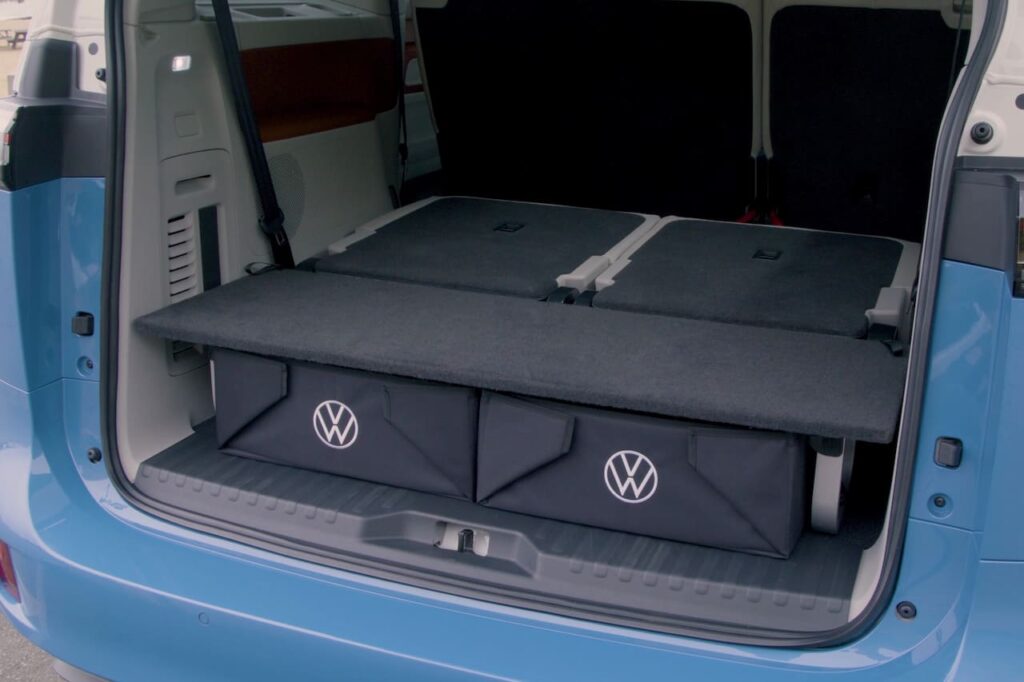
12-way power driver and passenger seats with dual armrests, ventilation, massage, and memory functions. Also part of the standard equipment is a heating function for the front seats and outboard second-row seats. The second-row seats can be reclined by 16º.
Refreshing colors
Bright colors make the cabin a pleasing place to relax. There are three interior color and trim choices. The first option is a combination of dark brown and black. It includes dark brown seats with white piping, blue door inserts and a dark wood-look dash, combined with black headliner and decor elements.
The second combination is light grey and clay. It includes light grey leatherette seats with clay-colored piping, clay door inserts, a light wood-look dash, and light grey decor pieces. The last option is a mix of light brown leatherette seats with yellow piping, light grey door inserts, and a washed wood-look dash, paired with black.

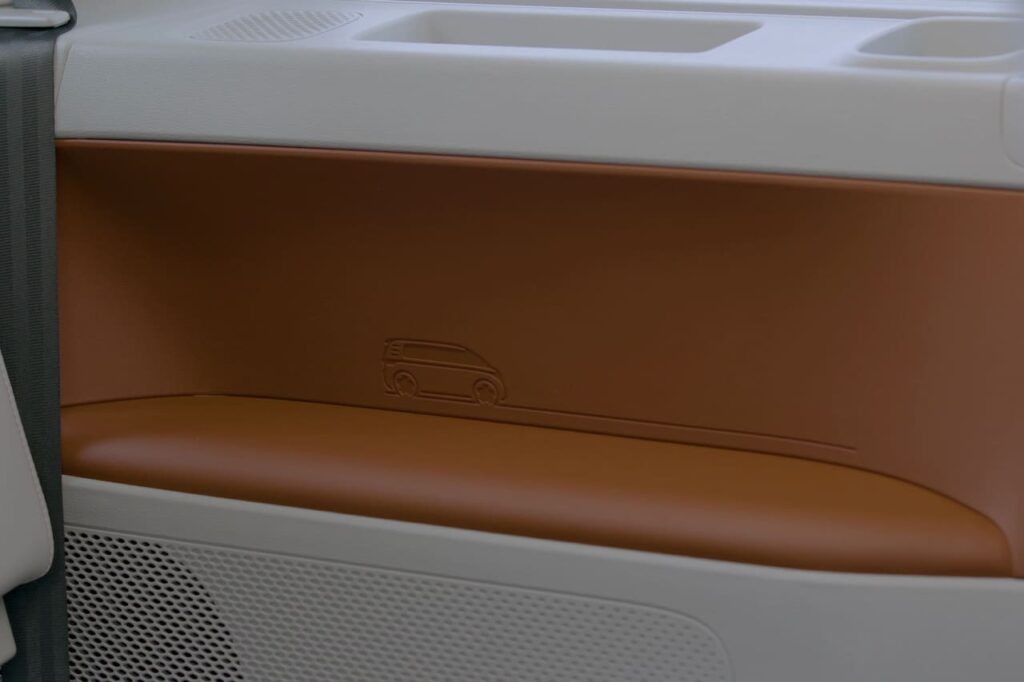
30-color ambient lighting including five preset moods is part of the standard equipment. The metal pedals feature pause (brake pedal) and play (accelerate pedal) symbols, a signature interior design cue of VW ID. models.
Buzz Box
The ID. Buzz features a detachable center console between the front seats. Marketed as ‘Buzz Box’ in other markets, the removable center console includes a drawer for keeping a laptop or clipboard, along with a cup holder, a flip-lid compartment for a water bottle, and storage bins. It consists of an ice scraper and a bottle opener, too, both always easily accessible. The Buzz Box comes from Grammer, an interior component supplier based in Ursensollen, Germany.
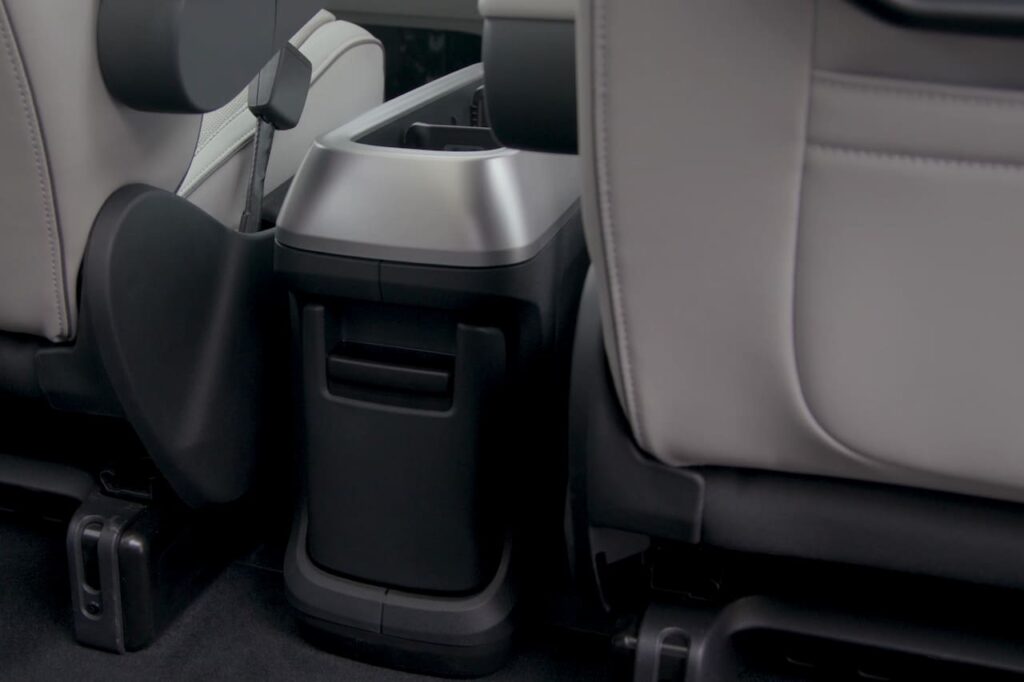
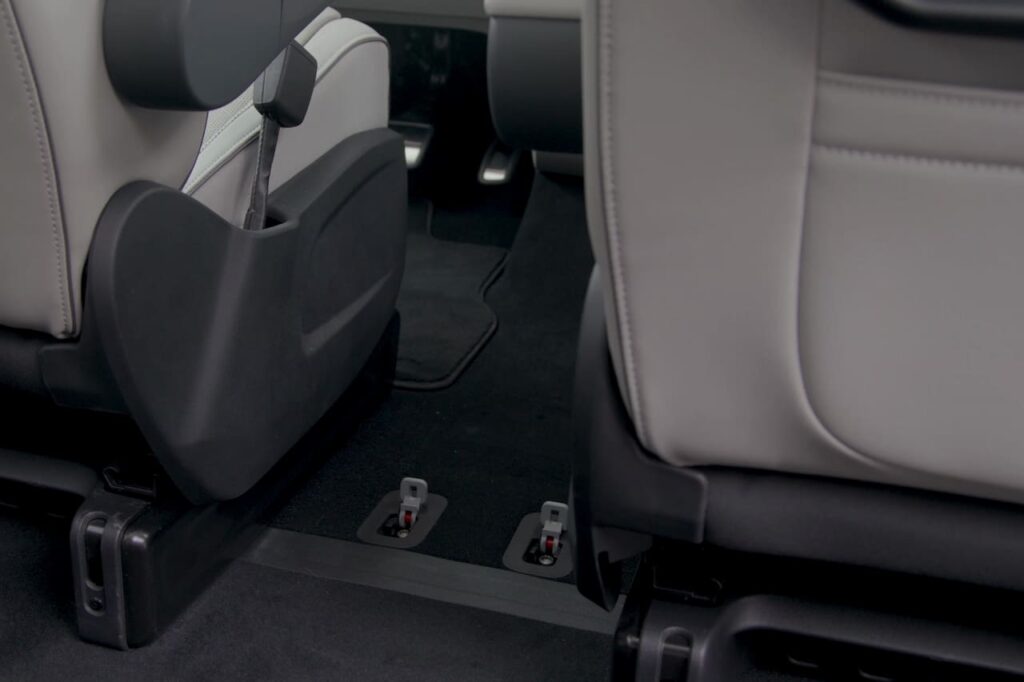
The clever center console can be released by pressing a button located at the rear of the storage compartment. In the Euro-spec model, the center console is fitted in the opposite direction, so that button is at the rear of the storage compartment by default. However, that doesn’t make a difference, as the center console is reversible. It’s just placed differently at the factory based on the customer preferences of the market where the model is headed.
ID. Light
ID. Light, an interactive light strip slyly placed below the windshield, gives visual alerts in different positions and different colors. It makes ADAS warnings, phone call alerts, navigation instructions, etc. more intuitive.
For example, for an instruction to change lane, ID. Light illuminates with a signal on the respective side (right or left). A signal in the right- or left-hand area of the strip, depending on the color, could also tell if there’s an obstruction in this area. When the entire light strip lights up in red, it means that the driver has to slam the brakes immediately, as it signals: “Beware! Brake!”
Additionally, ID. Light gives the voice assistant of the infotainment system a more human touch. Light pulses signal that the voice assistant is listening to the person talking to it like a real human. It produces light right in the driver’s field of vision, but in a subtle manner, ensuring it doesn’t affect their attentiveness. The ID. Light strip gives visual alerts in different positions and different colors.
Panoramic sunroof
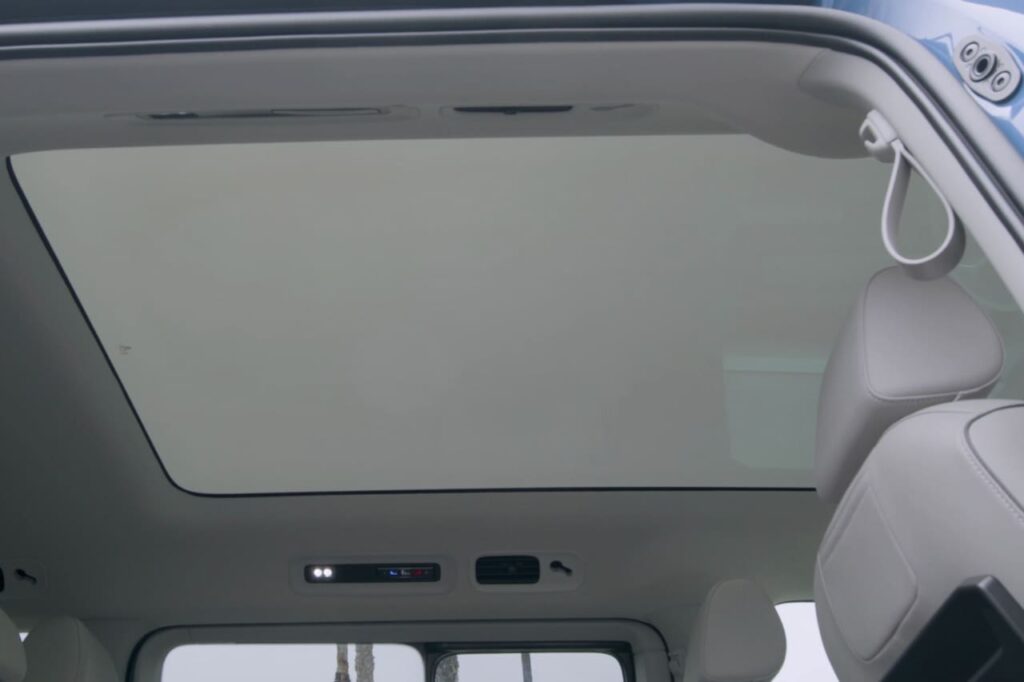
The ID. Buzz LWB features a gigantic panoramic sunroof. At 67.4 in. long and 40.8 in. wide, this is the largest sunroof on any Volkswagen Group model. That’s not the only highlight of this glass panel, though. It features electronic dimming and allows occupants to change from clear to opaque and back with the swipe of a finger.
Specifications
Dimensions
The U.S.-spec VW ID. Buzz measures 192.4 in. in length, 77.9 in. wide, and 74.6 in. tall. It has a 127.5-inch wheelbase, 9.9 in. longer than the ID. Buzz NWB (117.6 in.) that’s available in other markets. About as wide as the Atlas but five inches taller, a big box on wheels is what it is. If you’re still curious about the aerodynamic efficiency, its drag coefficient value is 0.29 Cd. That’s not a bad number for a vehicle of this shape.
The cargo space of the U.S.-spec ID. Buzz isn’t out yet, and we can’t assume the figure will be the same as that of the Euro-spec ID. Buzz LWB and say it’s 2,469 liters (87 cu. ft.). The latter measures 4,962 mm (195.4 in.), which makes it 3.0 in. longer than the former.
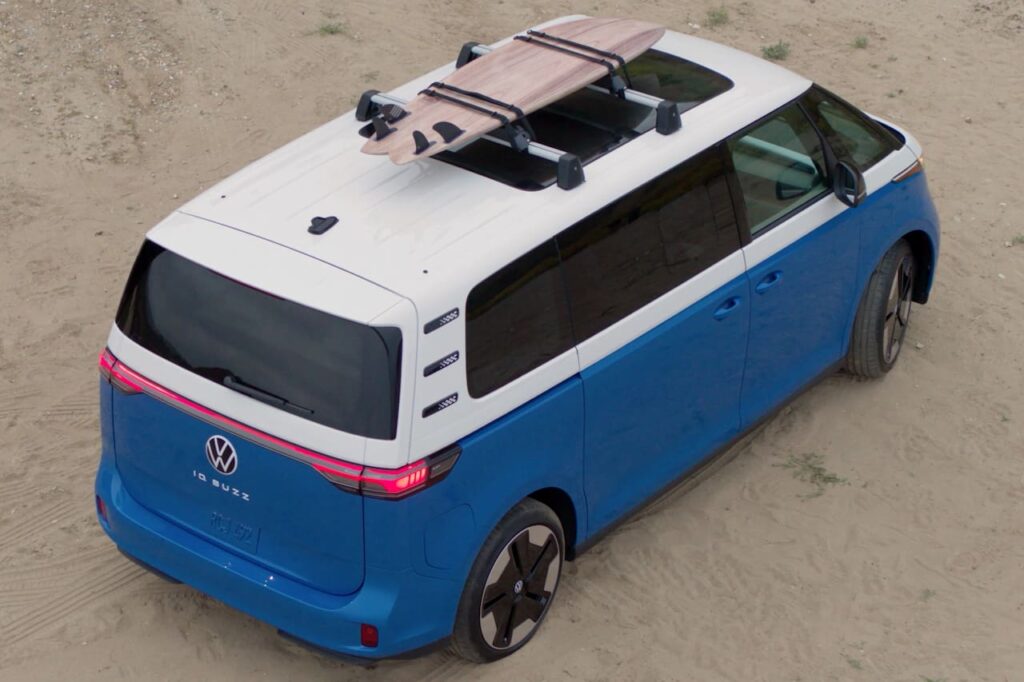
Performance & range
American customers will be able to buy the ID. Buzz in two configurations: RWD and AWD. The RWD variant borrows Volkswagen Group’s APP550 permanent magnet synchronous motor that debuted in the ID.7. Packaged with a normal one-speed transmission and a new inverter, this motor produces 282 horsepower. The AWD variant has two motors, one at each end, producing about 330 horsepower.
The U.S.-spec ID. Buzz has a top speed of 99 mph. The energy storage capacity of its battery pack is 91 kWh. That’s a gross rating, though; the net storage capacity is probably 85 kWh. Volkswagen is targeting an EPA-est. range of 260 miles for the RWD variant and 252 miles for the AWD variant. The confirmed EPA-rated range figures will likely be out a few weeks before launch.
Charging
Charging details haven’t been spelled out, but we think it’ll be possible to fast-charge the electric minivan at up to 200 kW. Expect a 5-80% charging session with a Level 3 charger to take as little as approximately 30 minutes. Rest assured, Plug and Charge support will be present. Customers won’t require the charging card authentication process at supporting charging stations. It will happen automatically via encrypted communication by plugging in the charging cable. Two years of complimentary 30-minute charging sessions at Electrify America charging stations is also a sure thing.
Bidirectional charging will likely be possible, allowing customers to power their home (vehicle-to-home), charge other EVs (with vehicle-to-vehicle), and, eventually, maybe even make money (with vehicle-to-grid). Bidirectional charging would come quite handy during camping trips to power external equipment like speakers, cooking appliances, lights, etc.
| Aspect | VW ID. Buzz RWD | VW ID. Buzz AWD |
| Length | 192.4 in. | 192.4 in. |
| Width | 77.9 in. | 77.9 in. |
| Height | 74.6 in. | 74.6 in. |
| Wheelbase | 127.5 | 127.5 |
| Platform | MEB | MEB |
| No. of Motor(s) | One | Two |
| Motor Power | 282 hp | ~330 hp |
| Battery Pack Capacity (gross) | 91 kWh | 91 kWh |
| Targeted Range | 260 miles | 252 miles |
Price & Release Date

The pure-electric VW bus may retail at over USD 60,000 in the base configuration. However, customers can take comfort in knowing that they’ll not be paying insane mark-ups or the so-called “market adjustment fees.” Pablo Di Si, President and CEO of Volkswagen of America, has indicated that the company is finding a way to ensure dealers don’t make customers pay more than the sticker price.
People shouldn’t pay more than the official price (MSRP), Di Si said during a media roundtable following the 2025 ID. Buzz debut, as per an Automotive News report dated June 2, 2023. “We cannot have mark-ups,” Di Si added, warning dealers against price gouging.
In an interview with Edison earlier in September 2023, Volkswagen R&D chief Kai Grünitz, revealed that the company will launch the ID. Buzz in the U.S. in Q1 2024 (January-March 2024). Moreover, he confirmed that Europe will also get the ID. Buzz long-wheelbase at the same time as the U.S.
Production
Production of the U.S.-spec VW ID. Buzz will take place alongside the global model at Volkswagen Commercial Vehicles (VWN)’s Hannover plant in Germany. Earlier, specific conversions were made to the Hannover facility to accommodate electric vehicle production—a new body shop was introduced, and new sections were added to the assembly line for EV components.
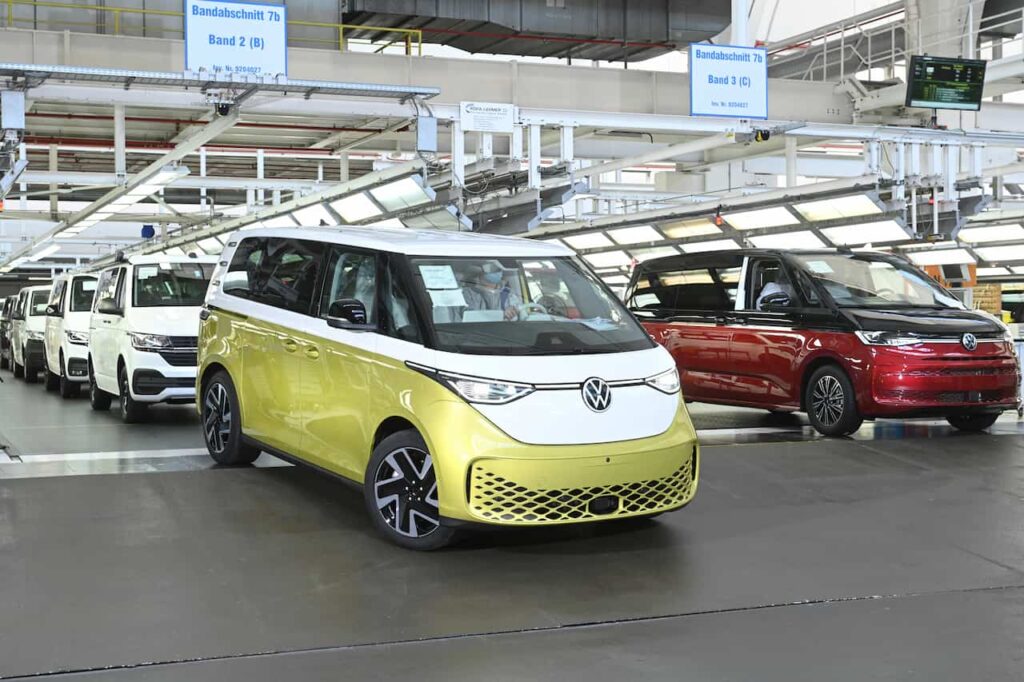
VWN received 26,600 orders for the ID. Buzz in 2022, but it was able to ship just 10,800 units. Only 6,000 units out of the 10,800 units that left the factory reached customers by the end of 2022, though. The company plans to make 44,000 units of the ID. Buzz in 2023, Dr. Josef Baumert, BoM member responsible for Production and Logistics, Volkswagen Commercial Vehicles, said, as per a report Automobilwoche published on March 23, 2023.
No U.S. production plans
In an interview with Automobilwoche in 2022, Carsten Intra, Chairman of the Board of Management at Volkswagen Commercial Vehicles, indicated that there’s no plan to make the ID. Buzz in the U.S. He said that demand for the ID. Buzz will grow in 2023 but VWN will not be able to increase annual production in Hannover to 130,000 units that year. However, when output hits that level eventually, “that will certainly be enough for Europe.” Asked whether that level of output will be enough for the U.S. as well, Intra said that there will be another surge in demand when the ID. Buzz arrives in the U.S.
The company will have to reevaluate the need to expand production capacity again. It may get the ID. Buzz made at the Volkswagen Poznań plant (Poland) if expansion in Hannover is impossible, but it is not considering other options, Intra said.
In June 2023, Automobilwoche probed the matter again, this time during an interaction with Dr. Astrid Fontaine, Chief Human Resources Officer, Volkswagen Commercial Vehicles. Dr. Fontaine right away denied the possibility. She said (translated) “It is clear in the site agreement that the ID. Buzz – no matter what form (NWB or LWB) – comes from Hanover.”
Significant customer interest recorded at U.S. dealers
During a conference call with the media on March 21, 2022, Scott Keogh said that the dealer response for the ID. Buzz in the U.S. “is significant,” as per a report from InsideEVs.com. Keogh, now in charge of Scout Motors, was the President and CEO of Volkswagen Group of America and CEO of Volkswagen North American Region then. Customers have started inquiring dealers about ID. Buzz reservations in the U.S. and one dealer has received 75 reservation inquiries, Keogh said. He said that the company could localize the ID. Buzz “if demand is beyond what Hannover can deliver.”
While speaking to Yahoo Finance on March 21, 2022, Keogh suggested that there’s a record-breaking demand for the ID. Buzz in the U.S. and Volkswagen will likely need to come prepared for an extremely high demand at launch. Keogh expects the ID. Buzz to be a “home run” for the German brand here.
The fact of the matter is I’ve never seen this much demand for a vehicle. I get emails from dealers, I get paintings from small children, I get hugs from grandmothers. They want to be first in line. So this thing just covers every spectrum imaginable. So I think it’s going to be a home run.
Scott Keogh, former President and CEO of Volkswagen Group of America and CEO of Volkswagen North American Region (Conversation with Yahoo Finance on March 21, 2022)
The classic VW Microbus was widely seen as a vehicle that brings families and friends together and gives people freedom and a way to support their adventurous spirit, all at an affordable price. It was popular among people who enjoyed an active lifestyle. Moreover, from Bob Dylan’s The Freewheelin’ album in 1963 to That ‘70s Show (the “love bus” first featured in Season 4) in 2001, and Little Miss Sunshine in 2006, the German van has always been a part of the pop culture in America.
Spotted on test
VW engineers are putting prototypes of the U.S.-bound ID. Buzz through its paces on American soil. A recent spotting, courtesy of Instagram channel kindelauto, shows the long-wheelbase electric minivan at a charging station in San Diego, California. This particular prototype is likely in the ‘Candy White’ solid color that is offered in the UK, fitted with the ‘Stockton’ silver alloy wheels.
TopElectricSUV says
The ID. Buzz is a great eco-friendly choice for families and people with an active lifestyle who don’t need the off-roading capabilities of an SUV. Whether you’re shopping at Costco or carrying your surfboard to the beach, this stylish EV will get you noticed. Now that the enthusiasm is there, all that’s needed to convert it into impressive sales figures are accessibly-priced variants.
Also See: VW ID. California electric campervan development begins
VW ID. Buzz FAQs
What is the VW ID. Buzz release date in America?
The ID. Buzz is expected to be launched in the U.S. in Q1 2024 (January-March 2024).
What will be the VW ID. Buzz price?
The base VW ID. Buzz in the U.S. will likely cost around USD 60,000 onwards.
Which models will be VW ID. Buzz alternatives?
The VW ID. Buzz will be a unique product in the U.S.
Featured Image Source: Volkswagen Group
